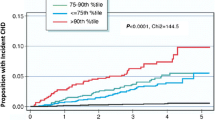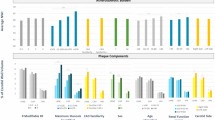Abstract
The presence of carotid arterial plaque by ultrasound enhances cardiovascular risk stratification beyond traditional risk factors. However, plaque quantification techniques require further outcomes-based investigation. The purpose of this study was to evaluate the utility of a focused carotid ultrasound protocol and novel plaque grading system developed by the American Society of Echocardiography (ASE). A retrospective analysis of 514 outpatients who were referred for coronary angiography between 2011 and 2014 was performed using a province-sponsored health database. All participants prospectively received a focused carotid ultrasound. Maximum plaque height (MPH) of arterial carotid plaque was quantified, using the Grade II–III plaque definition of MPH ≥ 1.5 mm for stratification, according to recent ASE recommendations. Participants were followed for 1.33–5.11 years (average follow-up = 3.60 ± 1.65 years) to identify the occurrence of cardiovascular events. Major events (death, myocardial infarction [MI], stroke, and transient ischemic attack [TIA]) were correlated to MPH. Participants with MPH ≥ 1.5 mm were more likely to experience stable angina, coronary artery bypass grafting, and stress testing at both 1-year and total follow-up. After adjusting for cardiac risk factors, increased MPH was shown to be predictive for TIA (odds ratio [OR] = 1.33, 95% confidence interval (CI) = 1.01–1.75); p = 0.04), whereas the odds of non-ST-elevation MI (OR = 1.55, 95% CI = 0.99–2.43; p = 0.06) approached significance. Using Kaplan–Meier survival analysis, MPH ≥ 1.5 mm demonstrated good separation for the composite outcome of death, MI, stroke, and TIA over total follow-up (p = 0.02). This rapid, office-based quantification of MPH in carotid ultrasound may serve as a stratification tool for predicting major cardiovascular events.



Similar content being viewed by others
References
Laslett LJ, Alagona P, Clark BA et al (2012) The worldwide environment of cardiovascular disease: prevalence, diagnosis, therapy, and policy issues: a report from the american college of cardiology. J Am Coll Cardiol 60:S1–S49. https://doi.org/10.1016/j.jacc.2012.11.002
Gaziano TA, Bitton A, Anand S et al (2010) Growing epidemic of coronary heart disease in low- and middle-income countries. Curr Probl Cardiol 35:72–115. https://doi.org/10.1016/j.cpcardiol.2009.10.002
Knuuti J, Wijns W, Saraste A et al (2020) 2019 ESC guidelines for the diagnosis and management of chronic coronary syndromes: the task force for the diagnosis and management of chronic coronary syndromes of the European Society of Cardiology (ESC). Eur Heart J 41:407–477. https://doi.org/10.1093/eurheartj/ehz425
Mangla A, Oliveros E, Williams KA, Kalra DK (2017) Cardiac imaging in the diagnosis of coronary artery disease. Curr Probl Cardiol 42:316–366. https://doi.org/10.1016/j.cpcardiol.2017.04.005
Johri AM, Behl P, Hétu M-F et al (2016) Carotid ultrasound maximum plaque height-a sensitive imaging biomarker for the assessment of significant coronary artery disease. Echocardiography 33:281–289. https://doi.org/10.1111/echo.13007
Patel SN, Rajaram V, Pandya S et al (2004) Emerging, noninvasive surrogate markers of atherosclerosis. Curr Atheroscler Rep 6:60–68. https://doi.org/10.1007/s11883-004-0117-3
Piepoli MF, Hoes AW, Agewall S et al (2016) 2016 European guidelines on cardiovascular disease prevention in clinical practice: the sixth joint task force of the european society of cardiology and other societies on cardiovascular disease prevention in clinical practice. Eur Hear J 37:2315–2381. https://doi.org/10.1093/eurheartj/ehw106
Inaba Y, Chen JA, Bergmann SR (2012) Carotid plaque, compared with carotid intima-media thickness, more accurately predicts coronary artery disease events: a meta-analysis. Atherosclerosis 220:128–133. https://doi.org/10.1016/j.atherosclerosis.2011.06.044
Park HW, Kim WH, Kim K-H et al (2013) Carotid plaque is associated with increased cardiac mortality in patients with coronary artery disease. Int J Cardiol 166:658–663. https://doi.org/10.1016/j.ijcard.2011.11.084
Wannarong T, Parraga G, Buchanan D et al (2013) Progression of carotid plaque volume predicts cardiovascular events. Stroke 44:1859–1865. https://doi.org/10.1161/STROKEAHA.113.001461
Grubic N, Colledanchise KN, Liblik K, Johri AM (2020) The role of carotid and femoral plaque burden in the diagnosis of coronary artery disease. Curr Cardiol Rep 22:121. https://doi.org/10.1007/s11886-020-01375-1
Johri AM, Nambi V, Naqvi TZ et al (2020) Recommendations for the assessment of carotid arterial plaque by ultrasound for the characterization of atherosclerosis and evaluation of cardiovascular risk: from the american society of echocardiography. J Am Soc Echocardiogr 33:917–933. https://doi.org/10.1016/j.echo.2020.04.021
Johri AM, Calnan CM, Matangi MF et al (2016) Focused vascular ultrasound for the assessment of atherosclerosis: a proof-of-concept study. J Am Soc Echocardiogr 29:842–849. https://doi.org/10.1016/j.echo.2016.05.003
Johri AM, Chitty DW, Matangi M et al (2013) Can carotid bulb plaque assessment rule out significant coronary artery disease? a comparison of plaque quantification by two- and three-dimensional ultrasound. J Am Soc Echocardiogr 26:86–95. https://doi.org/10.1016/j.echo.2012.09.005
Chan B (1999) Supply of physicians’ services in Ontario. Hosp Q 3:1–31
Mathiesen EB, Johnsen SH, Wilsgaard T et al (2011) Carotid plaque area and intima-media thickness in prediction of first-ever ischemic stroke: a 10-year follow-up of 6584 men and women: the Tromso Study. Stroke 42:972–978. https://doi.org/10.1161/STROKEAHA.110.589754
Nambi V, Chambless L, Folsom AR et al (2010) Carotid intima-media thickness and presence or absence of plaque improves prediction of coronary heart disease risk: the ARIC (Atherosclerosis Risk In Communities) study. J Am Coll Cardiol 55:1600–1607. https://doi.org/10.1016/j.jacc.2009.11.075
Polak JF, Szklo M, Kronmal RA et al (2013) The value of carotid artery plaque and intima media thickness for incident cardiovascular disease: the multi-ethnic study of atherosclerosis. J Am Heart Assoc 2:e000087. https://doi.org/10.1161/JAHA.113.000087
Tang W, Shen X, Li H et al (2019) The independent and incremental value of ultrasound carotid plaque length to predict the presence and severity of coronary artery disease: analysis from the carotid plaque length prospective registry. Eur Hear J - Cardiovasc Imaging. https://doi.org/10.1093/ehjci/jez304
Puvvula A, Jamthikar AD, Gupta D et al (2020) Morphological carotid plaque area is associated with glomerular filtration rate: a study of south asian indian patients with diabetes and chronic kidney disease. Angiology. https://doi.org/10.1177/0003319720910660
Stein JH, Korcarz CE, Hurst RT et al (2008) Use of carotid ultrasound to identify subclinical vascular disease and evaluate cardiovascular disease risk: a consensus statement from the American Society of Echocardiography Carotid Intima-Media Thickness Task Force. Endorsed by the Society for Vascula. J Am Soc Echocardiogr 21:93–190. https://doi.org/10.1016/j.echo.2007.11.011
Rundek T, Arif H, Boden-Albala B et al (2008) Carotid plaque, a subclinical precursor of vascular events: the Northern Manhattan Study. Neurology 70:1200–1207. https://doi.org/10.1212/01.wnl.0000303969.63165.34
Saba L, Montisci R, Famiglietti L et al (2013) Automated analysis of intima-media thickness: analysis and performance of CARES 3.0. J Ultrasound Med 32:1127–1135. https://doi.org/10.7863/ultra.32.7.1127
Austin PC, Lee DS, Fine JP (2016) Introduction to the analysis of survival data in the presence of competing risks. Circulation 133:601–609. https://doi.org/10.1161/CIRCULATIONAHA.115.017719
Saba L, Jain PK, Suri HS et al (2017) Plaque tissue morphology-based stroke risk stratification using carotid ultrasound: a polling-based PCA learning paradigm. J Med Syst. https://doi.org/10.1007/s10916-017-0745-0
Acknowledgements
This study was supported by the ICES, which is funded by an annual grant from the Ontario MOHLTC. The opinions, results and conclusions reported in this paper are those of the authors and are independent from the funding sources. No endorsement by ICES or the Ontario MOHLTC is intended or should be inferred. Parts of this material are based on data and/or information compiled and provided by CIHI. However, the analyses, conclusions, opinions, and statements expressed in the material are those of the author(s), and not necessarily those of CIHI.
Funding
Queen’s University (Department of Medicine Innovation Fund), Canada Foundation for Innovation (CFI IOF#29051), Ontario Research Fund, South Eastern Ontario Academic Medical Organization, and the Heart and Stroke Foundation of Canada (Phase I Career Award to AMJ), Kingston, Canada.
Author information
Authors and Affiliations
Contributions
All authors contributed to the study conception and design. Material preparation, data collection and analysis were performed by Amer M. Johri, Katherine A. Lajkosz, Nicholas Grubic, Terry Y. Li, Saadul Islam, Paul Ewart, and Marie-France Hétu. The first draft of the manuscript was written by Amer M. Johri and Marie-France Hétu, and all authors critically revised and commented on previous versions of the manuscript. Christopher S. Simpson and Jasjit S. Suri provided critical revisions to the manuscript. All authors read and approved the final manuscript.
Corresponding author
Ethics declarations
Conflict of interest
The authors declare no conflicts of interest.
Ethical approval
This study was approved by the Queen’s University Health Sciences and Affiliated Hospitals Research Ethics Board.
Consent to participate
Patients who were 18 years or above and provided informed consent, were enrolled in the study.
Consent to publish
No participants who consented to participate in this study objected to having their data published in a journal article.
Additional information
Publisher's Note
Springer Nature remains neutral with regard to jurisdictional claims in published maps and institutional affiliations.
Rights and permissions
About this article
Cite this article
Johri, A.M., Lajkosz, K.A., Grubic, N. et al. Maximum plaque height in carotid ultrasound predicts cardiovascular disease outcomes: a population-based validation study of the American society of echocardiography’s grade II–III plaque characterization and protocol. Int J Cardiovasc Imaging 37, 1601–1610 (2021). https://doi.org/10.1007/s10554-020-02144-5
Received:
Accepted:
Published:
Issue Date:
DOI: https://doi.org/10.1007/s10554-020-02144-5




